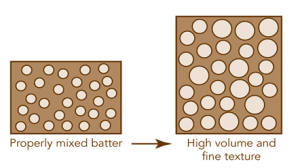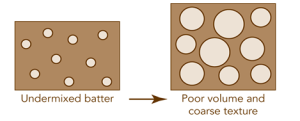5 Chapter 5-How the process of leavening works
Learning Objectives
How the process of leavening works
In the oven, gases expand filling the air pockets made during the mixing process. The gases then push on the wet, flexible cell walls of the mixture. This causes the cell walls to stretch and the product to rise. As the oven evaporates the moisture from the baked good, the product dries out, allowing the structure of the baked good to solidify, which then captures the air pockets to keep the aerated structure of the baked good intact.

(Figoni, p. 303)
It is important to understand how proper mixing of a batter or dough relates to a properly leavened end product.
Once the final batter is mixed, no new air cells are produced in the batter, so if a batter is under-mixed, there are not enough cell walls for the product to reach full volume and the resulting texture may be coarse.

(Figoni, p. 303)
If a product is over-mixed, there are too many air pockets and the resulting cell walls are thin and weak. The result is a product with low volume and the presence of a gummy layer of collapsed cells on the bottom of the product (especially in the example of a sponge cake).

(Figoni, p. 303)
While it is true that air cells created during the mixing method will expand with the oven’s heat, additionally, carbon dioxide formed by chemical leaveners will fill the air pockets and then expand to add additional volume to your baked good.
Check out this great time-lapse of pate a choux baking in the oven. The true power of steam!
Produce carbon dioxide in the presence of water and/or heat.

